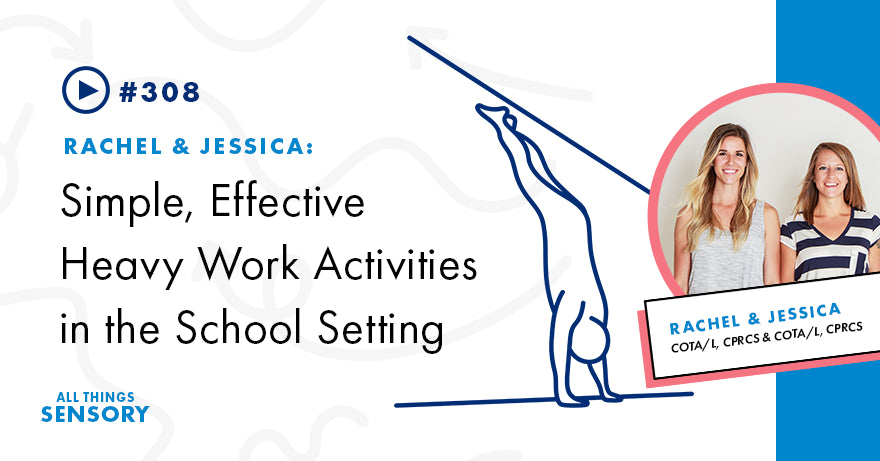Your Cart is Empty

We received a question from an OT practitioner working in the schools: What are some simple proprioceptive activities that I can do with my students that don’t require a lot of space or equipment?
Tune in for a discussion all about proprioception and get some new ideas for using heavy work and deep pressure in the school setting.
Make sure to check out all of our links below!
We’d love to answer your questions on the podcast! Fill out this form -> https://harkla.typeform.com/to/ItWxQNP3
All Things Sensory Podcast Instagram
Harkla Website - Shop Sensory Products!
How to Use the Harkla Weighted Compression Vest
10 Activities with a Mini Trampoline
Sensational Brain - Heavy Work for Teens and Children in School
Proprioceptive activities, or heavy work, are essential in creating a calming and organized student environment. By integrating these activities into schools' daily routines, we can help students meet their sensory needs, self-regulate, and enhance their learning experience.
Proprioceptive activities involve movements that provide deep pressure and resistance, stimulating the proprioceptive sense. This sense helps individuals understand their body position and movement in space.
For many children, especially those with sensory processing challenges, proprioceptive input can be incredibly soothing and organizing. It helps regulate their arousal level, making it easier for them to focus and participate in classroom activities.
Bubble Mountain is a fun activity promoting deep breathing and proprioceptive input to the oral structures. To do this activity, fill a bowl halfway with water, add dish soap, and blow bubbles with a straw.
Have the child lay on the ground while you gently roll a therapy ball or pillows over their body. This activity can be very calming and helps apply consistent pressure to different body parts.
Although not always classroom-friendly, chewing gum can be an excellent proprioceptive activity for OT sessions. It helps in providing oral proprioceptive input, which can be very regulating for some children.
Using a piece of lycra or a lycra tube, engage in a game of tug of war. This activity provides significant resistance and proprioceptive input, helping children to regulate their sensory needs.
Using weighted vests, blankets, or lap pads can provide consistent proprioceptive input. However, to ensure they are used safely and effectively, it's important to use these items under the guidance of a trained professional.
Animal walks, such as bear walks, crab walks, and frog hops, are excellent ways to provide proprioceptive input throughout the school day. These activities engage multiple muscle groups and can be easily integrated into transitions between classes.
Wall push-ups are a simple yet effective way to provide proprioceptive input. Students can push against the wall using different body parts, making them versatile for the classroom.
Encourage students to carry a stack of books to the library or between classrooms. This functional activity provides proprioceptive input through the weight of the books.
Have students lean against a wall and sit as if there is an invisible chair under them. This activity engages the core and leg muscles, providing deep proprioceptive input.
Tasks such as wiping whiteboards, stacking chairs, and organizing supplies can be excellent opportunities for proprioceptive input. These functional tasks also teach responsibility and life skills.
For older students, it's essential to incorporate activities that align with their interests and daily routines. Here are some ideas:
Introduce students to weightlifting or bodyweight exercises in the school gym. Activities like squats, deadlifts, and push-ups provide significant proprioceptive input.
Using a stationary bike can be an excellent way for students to get some movement and proprioceptive input without leaving the classroom.
Involving students in gardening tasks such as digging, planting, and moving soil can provide heavy work and a connection to nature.
Encourage students to help with tasks like setting up for assemblies, moving equipment, or cleaning the cafeteria. These activities provide proprioceptive input while teaching valuable life skills.
Incorporating proprioceptive activities into the school setting is a simple and effective way to help students regulate their sensory needs. Educators and therapists can create a more inclusive and supportive learning environment by integrating these activities into daily routines.
BORING, BUT NECESSARY LEGAL DISCLAIMERS
While we make every effort to share correct information, we are still learning. We will double check all of our facts but realize that medicine is a constantly changing science and art. One doctor / therapist may have a different way of doing things from another. We are simply presenting our views and opinions on how to address common sensory challenges, health related difficulties and what we have found to be beneficial that will be as evidenced based as possible. By listening to this podcast, you agree not to use this podcast as medical advice to treat any medical condition in either yourself or your children. Consult your child’s pediatrician/ therapist for any medical issues that he or she may be having. This entire disclaimer also applies to any guests or contributors to the podcast. Under no circumstances shall Rachel Harrington, Harkla, Jessica Hill, or any guests or contributors to the podcast, as well as any employees, associates, or affiliates of Harkla, be responsible for damages arising from use of the podcast.
Keep in mind that we may receive commissions when you click our links and make purchases. However, this does not impact our reviews and comparisons. We try our best to keep things fair and balanced, in order to help you make the best choice for you.
This podcast should not be used in any legal capacity whatsoever, including but not limited to establishing “standard of care” in a legal sense or as a basis for expert witness testimony. No guarantee is given regarding the accuracy of any statements or opinions made on the podcast.
Comments will be approved before showing up.